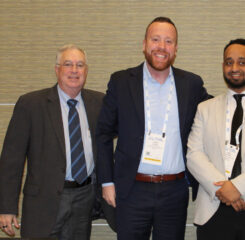LeadingAge Hosts Congressional Briefing: Addressing the Workforce Crisis in Aging Services
To coincide with our new campaign, “Aging Services Workforce Now,” LeadingAge held a Congressional Briefing on July 20, 2022, for Senate and House staff. The briefing was an opportunity for LeadingAge to share details on the aging services workforce crisis and highlight specific policy opportunities Congress could take to meet the needs of older Americans in the face of persistent and severe workforce shortage for aging services providers.
Katie Smith Sloan, President and CEO, LeadingAge, moderated the briefing and welcomed Rep. Ann Kuster (D-NH), co-chair of the newly formed bipartisan House 21st Century Long-Term Care Caucus, to share opening remarks. The Congresswoman co-chairs the Caucus along with Rep. Bryan Steil (R-WI). Representative Kuster spoke about the challenges plaguing the long-term care sector in her district, how employers are struggling to recruit workers, and challenges of retention as workers are drawn by competitive wages and flexible hours in other sectors.
Representative Kuster reiterated the Caucus’ commitment to directing attention to issues and solutions confronting the long-term care sector and to proactively studying ways to create a better long-term care system for older Americans. While the Caucus is still organizing and determining its agenda, the co-chairs have determined that addressing current workforce challenges is the first area the Caucus wants to address, Representative Kuster said.
Mike King, LeadingAge Board Chair and President & CEO of Volunteers of America (VOA), Alexandria, VA, welcomed attendees and spoke about VOA’s experience. He noted there is a 35-45% turnover rate within VOA communities. Many have a 25-30% vacancy rate and cannot accept new clients who come in because there are not enough staff to serve them. “It’s an absolute life or death crisis in being able to get that skilled care that you must get. That is why this is a crucial and important issue for us to resolve in our country,” Mr. King said. He added “aging services employees who have had the most difficult last three years are the heroes of the pandemic and we owe it to them to bring in more folks to support them.”
Ms. Sloan highlighted the top findings in the LeadingAge workforce snap poll, conducted in June 2022. “Even though we are entering another new and different phase of the pandemic, [the aging services] workforce situation is not improving,” Ms. Sloan shared. “When we asked why staff are leaving at such high rates, three-quarters say staff are leaving for higher pay. Further, 72% told us that staff are leaving because they are simply burned out. We also heard from members the pipeline is not getting stronger, and nursing positions are especially difficult to fill.”
LeadingAge Provider Member Highlights:
The briefing allowed LeadingAge provider members to share their experiences with the workforce crisis, which included the following:
Tom Syverson, Director of Government Relations, Good Samaritan Society / Sanford Health, Sioux Falls, SD.
-
The workforce crisis we are experiencing right now cannot be overstated. I have never seen anything like this in my 35-year career in post-acute services. To address this crisis, the Good Samaritan Society has supported our people by making historic investments in wages ($15 million in 2021 and another $5 million already this year), creating an online certified nurse training course, and endeavoring to recruit over 200 international nurses. At Sanford Health we have a goal to recruit 500 international nurses as our hospitals also battle this healthcare staffing crisis.”
-
Our turnover rate is below the national average, but staffing challenges remain a real concern, and it’s even more challenging in rural areas. We currently have more than 2,540 open positions in our organization. That means about 1 in 4 positions are not filled. It is taking on average 60 to 65 days to fill an open position.
-
Throughout the last two years, we have had to increase the number of agency staff across all of our locations to maintain the level of quality care our residents deserve. In some cases, we’re paying physician wages for RNs in our buildings. Additionally, in half of our 22 states, Medicaid reimbursement rates do not even cover our staffing costs and staffing accounts for only two thirds of our total costs.
Jeff Farber, President & CEO, The New Jewish Home, New York, NY.
-
At The New Jewish Home, we recognized that there was a challenge bringing in new talent to the workforce and that not enough people, earlier in their career, were interested in our fields. Sixteen years ago, we partnered with a local public high school located in Harlem, New York City, that had below average graduation rates and was underfunded to create the “Geriatrics Careers Development” (GCD) program that allows for “early-in career” exposure to aging services. We provided school tutoring and support and we put the high school students on the floors. The students spent hundreds of hours in direct contact with older people so they could develop meaningful relationships.
-
GCD currently partners with 10 public high schools in Harlem and the Bronx, helping to train sophomore, junior and senior high school students to receive allied health certifications – CNAs, home health aides, patient care technicians, EKG techs and phlebotomists. The 3-year program has trained over 1,000 students over 16 years, many of whom are first generation immigrants. Over 225 students participate annually, and 100% are college bound. To date, more than 500 allied health certifications have been awarded. We have also replicated the program at another community in Milwaukee, Wisconsin, and it is going very well.
-
The New Jewish Home created a second program where we partner with local social service agencies to create cohorts of young adult students and provide them with various health care certifications within three months. This program targets disadvantaged and underemployed young adults, 18 to 24 years of age.
You can also view two video clips regarding The New Jewish Home GCD program. The first is a CBS evening news piece about the program; the second is a message from a GCD alumna, Francisca Fadairo, speaking to an audience regarding the impact the program has had on her life.
Links to both:
Rob Lahammer, Vice President of Engagement and Advocacy, Presbyterian Homes and Services, Roseville, MN.
-
Currently, in Minnesota, there are 28,000 openings for employees in senior care right now. We had six nursing home closures this year, and 40 are very close to closing. In Presby Homes there are presently 15 open positions, and turnover runs anywhere from 40-120%.
-
Presby Homes has implemented an International Nurse Recruitment (INR) program, which has deployed over 450 people into its organization since 2001, by mostly recruiting nurses from the Philippines. Currently, Presby Homes has 129 nurses from its INR program, which is approximately 17% of their hourly nurse workforce. In addition, 74 of INR program nurses’ family members also work for Presby Homes.
-
Overseas employment agencies (mostly in Asia Pacific) who are deploying healthcare workers to the United States are faced with global challenges. Competition has significantly increased and resulted in candidates declining offers to work in the United States and opting to take jobs in other countries.
-
Furthermore, immigration policies have slowed down opportunities to hire international workers. At one time, Presby Homes had 26% of our hourly nurses coming in through the INR program, now we’re down to 17%.
-
Potential solutions should include a discussion about legal immigration. We also should open more visas, creating a point system like Canada and Australia have. Additionally, we should devote resources to recapture existing visas [for health care workers] and have a targeted immigration program for caregivers.
Ruth Katz, Senior Vice President for Policy, LeadingAge, concluded the briefing and emphasized while there is not one solution to address the aging services workforce crisis, Congress is in the position to make changes and enact the Key Legislative Solutions outlined in the Aging Services Workforce Now Campaign. LeadingAge calls on Congress to act immediately to:
-
Pay aging professionals a living wage.
-
Offer incentives to retain and attract qualified staff.
-
Expand training and advancement opportunities.
-
Build dependable international pipelines of trained caregivers.
-
Enact meaningful, equitable long-term care financing.
Read all about the Aging Services Workforce Now Campaign

Most Recommended
October 15, 2025
 Shutdown Week Three: Impact of Ongoing Closure on Affordable Housing
Shutdown Week Three: Impact of Ongoing Closure on Affordable Housing
December 10, 2025
Fiscal Year (FY) Funding 2026
October 07, 2025
Immigrant Workforce Matching Program Brings Workforce Relief
Recently Added
December 16, 2025
Congress Responds to DOE’s Proposed ‘Professional Degree’ Definition
December 15, 2025



